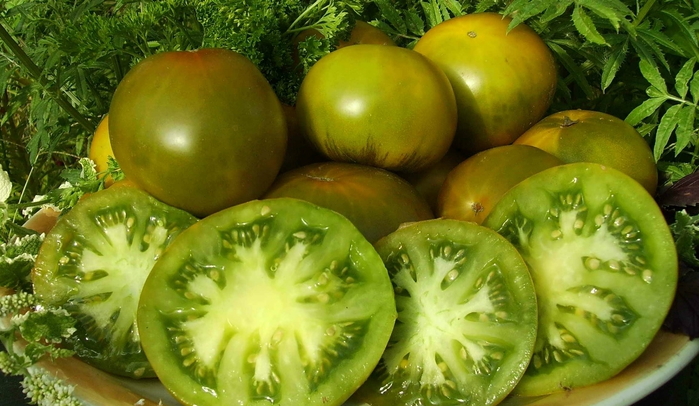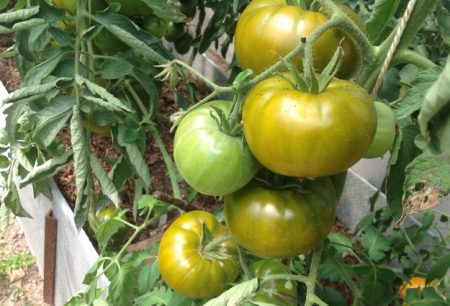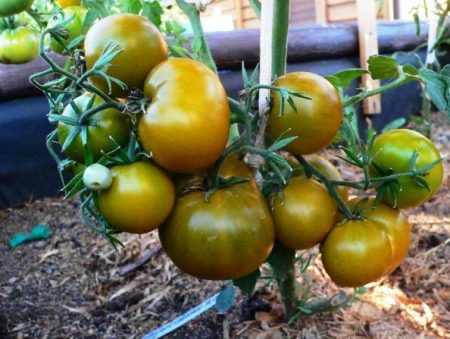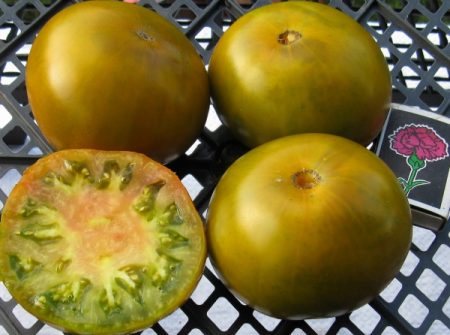 The original green color of ripe tomatoes in combination with a sweet and sour taste attracts many gardeners. Although, in order to grow the Swamp variety, it still requires effort, since it does not belong to the most unpretentious varieties.
The original green color of ripe tomatoes in combination with a sweet and sour taste attracts many gardeners. Although, in order to grow the Swamp variety, it still requires effort, since it does not belong to the most unpretentious varieties.
Content
- 1 Characteristics and description of the variety
- 2 Productivity
- 3 Reviews of those who planted
- 4 Features of cultivation and care of the variety
- 5 Advantages and disadvantages of the variety
- 6 Ripening speed
- 7 The main purpose of the variety
- 8 What regions are grown
- 9 Resistance to disease and adverse conditions
- 10 The timing of planting seeds for seedlings, how to sow
Characteristics and description of the variety
The tomato bushes are indeterminate, that is, they grow all the time, even after flowering. Therefore, the bushes are quite high, up to 1.5 m and they need to be tied up. Bushes are medium leafy, have large green leaves. If you feel the sheet, then it is loose and has a slight corrugation. The variety was included in the State Register of Breeding Achievements in 2004. The first inflorescence is formed over 9 leaves, then every 3 leaves. Inflorescences are simple to intermediate.
Plant height
If you plant seedlings in an open area, then the bushes grow to a height of 1-1.1 m, and if in a greenhouse, then one and a half meters.
Color, fruit shape, weight
Tomatoes are flat-round in shape; ribs are clearly visible. If the bushes are planted in a greenhouse, then you can collect fruits weighing 280-310 g, and from the bushes in an open area remove tomatoes weighing 150-220 g. Unripe tomatoes are green, and ripened tomatoes are also green, but have pinkish or yellowish blotches, and a dark green speck of a stalk characteristic of tomatoes.
Productivity
4.8-5.5 kg of tomatoes are collected from 1 m2 of an open area, and if seedlings are planted in a greenhouse, then from 1 m2 to 5.4-6.0 kg. At the same time, 3 bushes are planted on 1 m2.
Reviews of those who planted
According to gardeners, tomatoes are great for pickling whole fruits. People really like the unusual green color of ripe tomatoes and the sweet and sour taste.
Features of cultivation and care of the variety
For landing, select a well-lit area. It is better if before it cauliflower, carrots, cucumbers grew.
In the fall, prepare the site. Use 4 kg of humus, scattering it over 1 m2 of land, and then dig it up. Take away all the weeds. And early in the spring, sprinkle 1 m2 of soil - 80 g of superphosphate and 20 g of potassium chloride, dig it again.
Plant seedlings on a cool, cloudy but still day. When planting, deepen the stems 2 cm into the ground, then additional roots will grow. Prepare supports immediately and tie up bushes. You can use trellis. After planting, pour the tomatoes with warm water.
When planting seedlings, it is better to form a bush in 2 stems, tie them up, timely cut off the stepsons.
Bushes are constantly watered with warm water once every 3-4 days, after watering, be sure to loosen the soil so that it does not form a crust, pick up weeds. For a season, feed 2-3 times with nitroammophos. Before fertilizing, water the bushes abundantly, and after top dressing, water again.
You can make such fertilizer instead of nitroammophoski by feeding the tomatoes 2 weeks after planting the seedlings on the plot: pour part of the chicken manure in a bucket and 15 pour 15 parts of water, then pour 300 g of ash and 50 g of superphosphate. Mix everything well. Buckets of such fertilizer are enough for 15-20 bushes.
Tear off the lower leaves when the bushes grow enough.
If you spray the bushes with the composition "Epin-extra", then the tomatoes will be better tied and a larger amount of yield will grow. To prevent fungal diseases, you can spray the plants with compounds in which copper or sulfur is present.
Advantages and disadvantages of the variety
Benefits:
- unusual color and type of tomatoes;
- excellent sweet and sour taste;
- fruits can be canned and eat fresh;
- the fruits ripen early.
Disadvantages:
- bushes should be tied up and removed stepsons;
- when compared with determinant varieties that stop growing at the beginning of flowering, the vegetative part develops for a long time;
- the fruits do not lie long, since they are loose.

Ripening speed
The variety is classified as early, since only 95-98 days pass from sowing seeds to harvesting.
The main purpose of the variety
Tomatoes are great for canning, they are pickled whole, without cutting, and they are also eaten fresh.
What regions are grown
In the southern regions of Russia, bushes are planted in an open area, and in the northern regions - in greenhouses and greenhouses.
Resistance to disease and adverse conditions
The variety, unfortunately, is not resistant to anthracnose; the disease affects the roots and fruits of plants. The affected areas become soft, turn brown, then black, and then dry.
To prevent the disease, tomato seeds are etched with an immunocytophyte solution. And seedlings are sprayed with “Quadrice” or “Flint”.
If the bushes have already contracted anthracnose, then they are sprayed with such compounds as Tiovit Jet and copper chloroxide.
The timing of planting seeds for seedlings, how to sow
Tomato seeds are sown in the house for seedlings from February 20 to March 10.
Check the seeds before planting. Pour a spoonful of salt into a glass of water and place the seeds in the glass for 15 minutes. Bad seeds will come up, and good seeds will be at the bottom. Rinse them, dry them. Next, place the seeds in a damp cloth and wait 24 hours.
It is better to sow 3-5 seeds to a depth of 1 cm in one plastic cup, then shoots will not need to be dived. Moisten the soil thoroughly after planting.
When each bush will have 6-8 leaves, and it will be 25 cm high, then it can be planted in an open area. In the Central region of Russia, this is done at the end of May.
Thus, the Swamp tomato is distinguished by unusual greenish fruits that can be put in salads.




 Low-growing tomatoes, without pinching: 5 of the most delicious varieties
Low-growing tomatoes, without pinching: 5 of the most delicious varieties Why tomato seedlings grow poorly
Why tomato seedlings grow poorly We grow a tomato in a shell
We grow a tomato in a shell Growing tomatoes without watering according to the method of Kazarin
Growing tomatoes without watering according to the method of Kazarin